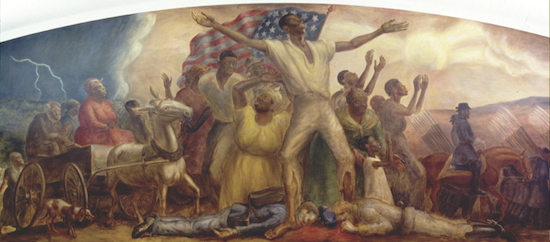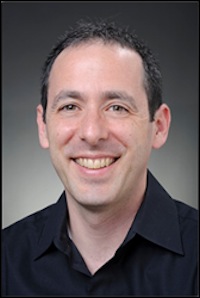UW Curry mural tells forgotten emancipation story

John Steuart Curry’s mural “The Freeing of the Slaves” in the UW Law School portrays the slaves themselves as drivers of their emancipation, says history Professor Steve Kantrowitz.
With a sweep of his pen, Abraham Lincoln changed the lives of 4 million black Americans when he signed the Emancipation Proclamation that led to the 13th Amendment outlawing slavery in the U.S. But a striking, often-overlooked campus mural by John Steuart Curry tells a part of the story that’s often forgotten.
“The Freeing of the Slaves” adorns the north Reading Room wall of the UW Law Library on Bascom Hill. The central figure — a black man with arms upheld — is almost 11 feet tall. At his feet lie two soldiers: one Confederate, one Union. Recently-freed slaves crowd around, while in the background the Union army marches off victorious, in perfect formation.

Kantrowitz
“It’s tempting to read this as the classic story of how the Union Army freed the slaves, and the dead soldiers as the cost of that freedom,” says history professor Steve Kantrowitz. “But at the center of this mural are the slaves themselves, who have essentially set in motion their own liberation.”
As the 150th anniversary of the Emancipation Proclamation approaches (Lincoln signed the edict on Jan. 1, 1863), Kantrowitz is engaging the campus and the broader community in conversations about slavery and its aftermath.
At the heart of Kantrowitz’s effort: a desire to broaden understanding of African-Americans’ role in securing their freedom and citizenship. For this reason, the Curry mural interests him.
“When the Civil War began, everyone on both sides was very clear: this was not a war of emancipation. And yet somehow, by 1863, Lincoln has put his pen to a proclamation that says quite the contrary,” says Kantrowitz. “Curry’s mural shows, in a profound and powerful way, that the slaves themselves were driving that.”
“Emancipations,” a yearlong series of talks conceived by Kantrowitz and cosponsored by the Center for the Humanities (along with other campus partners), delves deep into the events leading up to the freeing of the slaves, as well as the struggles that followed. In free public talks across campus, visiting historians will address many topics, including the role of fugitive slaves and northern black abolitionists, the post-Civil War chaos that created conditions of unimaginable difficulty for newly freed slaves, and the long-term legacies of slavery, including contemporary mass incarceration of African-Americans.
On Nov. 8, Kantrowitz will be a featured guest at the Wisconsin Book Festival, discussing his new book, “More Than Freedom: Fighting for Black Citizenship in a White Republic, 1829-1889,” along with independent historian David Cecelski, author of “The Fire of Freedom: Abraham Galloway and the Slaves’ Civil War.” Kantrowitz’s book focuses on black reformers in the city of Boston — some of them former slaves — who fiercely challenged whites to recognize them as equal participants in American life.
“When the Civil War began, everyone on both sides was very clear: this was not a war of emancipation. And yet somehow, by 1863, Lincoln has put his pen to a proclamation that says quite the contrary. Curry’s mural shows, in a profound and powerful way, that the slaves themselves were driving that.”
Steve Kantrowitz
“This group wasn’t just looking for a set of specific rights; they wanted recognition as ‘brothers and equals,'” says Kantrowitz.
The new Steven Spielberg movie “Lincoln,” set to be released this month, will focus on the Emancipation Proclamation, perhaps the greatest legacy of any president. But don’t forget it’s only one part of a very complex story, Kantrowitz says.
“Our national storytelling around this event tends to taper off at reconstruction,” he says. “But that was just the beginning.”
The revolutionary energy that gripped the nation at the moment of emancipation soon faded, as the project of transforming former slaves into citizens proved difficult. The notion of America as a “white republic” seemed to become more entrenched as the years went by.
But even through the “bitter times” of the late 19th and early 20th centuries, there were always people — not only blacks, but some whites, too — who championed egalitarianism. One of them was Lloyd Garrison, dean of the UW Law School, who commissioned Curry to paint the sweeping mural on the north wall of the Law Library’s Reading Room.
Curry had first proposed the mural for the new Justice Department building in Washington, D.C. But nervous politicians rejected it. The painter, who had just begun a 10-year term as artist-in-residence at UW–Madison, shared the idea with Dean Garrison.
Garrison also happened to be the grandson of the famous white abolitionist, William Lloyd Garrison. With a $6,000 donation from the Pabst family of Milwaukee, Garrison commissioned Curry to paint the mural in the new law library, then under construction.
“I felt from the beginning that the mural would be appropriate for the law building,” wrote Garrison. “[It] proclaims in a noble and patriotic setting the dignity and freedom of all people. “
Dean Garrison, says Kantrowitz, represented the almost-lost tradition of egalitarianism and emancipationism that had gripped the country in his grandfather’s day. Its resurgence in the late 1930s eventually led to the civil rights movement.
“The 150th anniversary of the Emancipation Proclamation offers a time to reflect,” says Kantrowitz. “Today, an African-American is president. At the same time, one out of four black men can expect to be incarcerated. Between the grand vision of 150 years ago and the reality of today are the missing pieces of a conversation about what freedom really means.”
—Mary Ellen Gabriel




